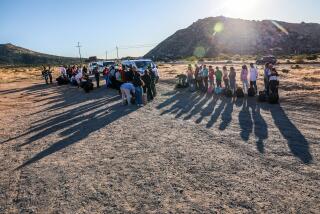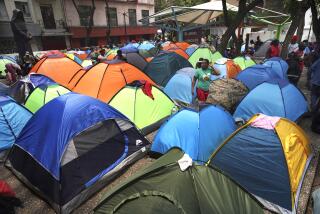Homeless Aliens Drift Amid S. County Wealth : Immigration: With unattainable prosperity in sight, Latino migrants make their homes in boxes and bushes. They hop freights to Orange County to seek a better life.
DANA POINT — Shivering in the dark boxcar, chilled by ocean winds, the Latino men crouch as the freight train slows around a bend.
When the train decelerates to 20 m.p.h., the men jump, hitting loose rock and gravel with a crunch, and roll to a stop.
On the other side of the tracks, lights beckon from a tract of upscale Dana Point homes. The men stand up, dust themselves off and slip into the underbrush to find shelter for the night.
For illegal immigrants without family or friends in Orange County, the tangled underbrush of Dana Point and San Juan Capistrano becomes a home for what local social workers and law enforcement officials are calling the largest pocket of homeless people in South County.
They sleep in tents, cardboard boxes or sometimes hollow out the middle of a large bush wherever there is undeveloped land. The winter mornings chill their bones, and meals are sporadic at best when money runs low.
To ease the boredom between jobs, the pain of separation from families and the alienation of life in a strange country, some find solace in alcohol, while others take comfort in religion.
Benito Cano Solis smiles broadly as he welcomes newcomers to his home for the past six months, a battered cardboard refrigerator box that is hidden by dense underbrush growing on the dusty riverbed of San Juan Creek.
In the evening gloom, his candle shines brightly as the young illegal alien puts down a battered, brown Bible.
“This is not a normal life,” Solis says, speaking softly. “But I have faith, and I will work hard. What more do you need?”
But with cities all over Orange County cracking down on dayworkers and their employers, opportunities to work have been scarce. Solis has not found employment for four days. From the tenuous grapevine that connects the illegal-migrant underground in Southern California, Solis has heard that there are jobs “somewhere in the north. I will probably go soon.”
Church and law enforcement officials say Solis is typical of the homeless Latino illegal alien--a teen- to middle-age man who has left family and friends to find a better life in the United States.
Alone, often desperate to send money back home, they migrate throughout California in search of jobs.
For many transients, the freight trains are a taxi service that leaves hourly from the train yards of San Diego and travels north through Orange County to Corona, say Santa Fe Railway officials.
“At any time of the day you can count 100 or more of them” hitching a ride in boxcars, said Jim Cassady, whose San Juan Capistrano plant nursery borders the railroad tracks.
Exactly how many jump off at the Capistrano Beach section of Dana Point is unknown, although a local church volunteer estimated that at least two dozen people are currently living in the hills and bushes by the railroad tracks, setting up makeshift camps on both sides of the Dana Point-San Juan Capistrano border.
Orange County sheriff’s deputies say the homeless Latino population there swells during the warm summer months.
“Sometimes it gets up to between 50 and 60 people that are visible,” said Lt. Dan Martini, a Sheriff’s Department spokesman. “I’d say it is the biggest group of homeless in South County.”
But now it is winter, and at night the Pacific winds bite deeply.
Like a bear emerging from a winter cave, Luis Rivera shoves his head out of a pup tent and groans.
“Ay, it is cold,” he said, but with heavy breezes bending the dry scrub brush surrounding the camp. “It is too dangerous to make fire.”
The small tent starts to shake as two teen-agers from Guatemala, who have shared the tent with Rivera for five months, struggle to leave the shelter. “I think it is a snake,” he jokes.
A row of shoes and boots line the outside of the tent. Covered with dirt, Rivera’s sneakers stand out because he is the only one who found work that day. Pulling out his wallet, he displays some of the $45 he earned carrying cement bags at a construction site “in Mission Viejo, I think,” Rivera said.
As it was the first money he has made in a week, $10 went immediately to buy dinner for the three men. Crumpled Burger King bags by the tent are all that remains of the evening meal.
The remaining cash will last three days, said Rivera, until Wednesday, when they will eat at a soup kitchen run by Calvary Church in Dana Point. Thursday will take care of itself.
Lydia Martinez, a Calvary Church administrator, said she is constantly amazed by the courage of illegal aliens such as Solis and Rivera.
“These are men with families far away who are willing to take whatever risk there is to feed their children and clothe them,” said Martinez. “I have total admiration for them.”
“When you see them walk into the church, they have a sense of pride and a sense of cleanliness,” she said. “But sometimes they are embarrassed when they come to eat when they are not clean.”
“Other times they sit and they’ll cry because they cannot bring their families,” Martinez said. “They see the life style of the rich in Dana Point, but they can’t touch it. It makes me want to cry.”
If nothing else, Miguel Castro has a room with a view. It is a hazy morning, but from Castro’s lean-to--a sheet of ply board reclining against a large bush with a slab of dirty foam rubber serving as bedding--hundreds of expensive homes can be seen dotting the surrounding hills.
“I do not think much about them,” said Castro, 29, who came to Dana Point from Mexico two months ago. “Why? I cannot even buy an apartment.”
Castro said he feels pressure to send money to his wife and four children, who are living with relatives near Mexico City. Last week he sent them $50, which he said will feed his family for a month.
He keeps a picture of them in a plastic bag in back of his lean-to. The photo, filled with smiling children, is dog-eared from loving handling.
In the United States, Castro’s day starts at sunrise with a mile-long walk along the tracks to Capistrano Beach, where he will take a sponge bath from a cold water tap. By 8 a.m. he is ready to join several other Latinos looking for employment along Doheny Park Road in defiance of a 2-month-old Dana Point ordinance that bans solicitation of dayworkers on the street.
Up to 200 Latinos crowded a block-long section of Doheny Park before sheriff’s deputies stationed in Dana Point began enforcing the city law. Now, only about 20 to 30 dayworkers remain.
“They don’t give us any trouble,” said Sheriff’s Deputy Dan Salcedo. “They just shrug their shoulders and move on. I don’t know where they go.”
At 10 a.m., Castro gives up the wait and walks to a nearby doughnut shop. The rest of the day will be spent talking with friends in front of Capistrano Beach stores. At night they pool their resources to buy beer and drink it outside on a stack of abandoned wooden pallets.
“Nothing more to do,” he says.
Poverty and boredom aside, Castro and other illegal aliens say their greatest fear is being caught and deported by the U.S. Immigration and Naturalization Service.
Walking to the beach along the tracks, Solis’ eyes are constantly scanning the terrain ahead. “The immigration,” he explains. “I have been sent back two times already.”
INS border patrol spokesman Ted Swofford said agents are aware of the Capistrano Beach bush dwellers.
“We make daytime patrols of the day laborers,” he said. But “as far as going out of our way to raid their sleeping areas, that’s not something we are used to doing.”
The INS does make constant checks of the trains running between San Diego and Orange County, Swofford said, adding that Dana Point has long been a drop-off point for illegal immigrants.
City officials and law enforcement officers in both Dana Point and San Juan Capistrano say transients have camped out near the railroad tracks for at least 15 years, or longer.
“Actually, travelers have stopped over in San Juan Capistrano on their way north for centuries,” said San Juan Capistrano City Manager Stephen B. Julien.
Fourteen years ago, Christian Pederson found out what it was like to be homeless in Dana Point.
The San Clemente auto mechanic was living in his native Peru when a friend described the opportunities in the United States.
“He told me about the nice houses and the cars and I said, ‘Why not go?’ ” Pederson recalled.
After a hazardous trip that was marred by several run-ins with police in South America and Mexico, Pederson arrived in South County. His first home was a deserted fisherman’s shack in Dana Point Harbor where he stayed for several weeks until enough money could be saved for an apartment.
Today, he owns his own auto road service and volunteers at Calvary Church. In training to become a pastor, Pederson conducts worship services where he finds illegal immigrants willing to listen.
“I was hurt, I was miserable and God gave me life,” he said. “So when I see people who are hurting, I have to do something about it.”
On one recent morning, Pederson gathered four illegal aliens, including Solis, outside an art supply store in Capistrano Beach for an impromptu fellowship service.
As cold winds blew small scraps of paper around the tiny congregation, the men stood in a circle with their heads bowed while Pederson recited prayers in Spanish on the concrete sidewalks outside the store.
“They seem so eager,” Pederson said. “They have a vision of prosperity for the future. I try to teach them hope.”
More to Read
Sign up for Essential California
The most important California stories and recommendations in your inbox every morning.
You may occasionally receive promotional content from the Los Angeles Times.










